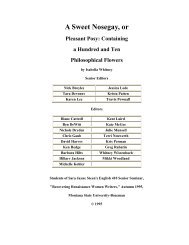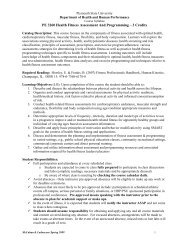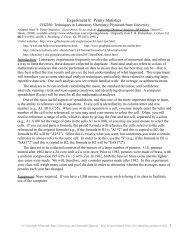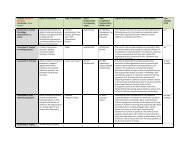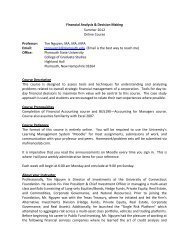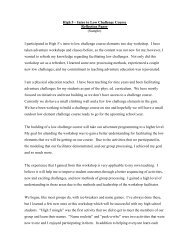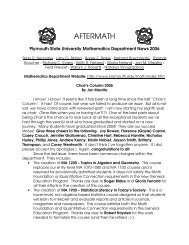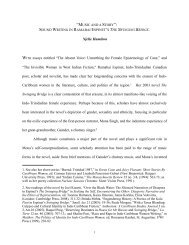2007-2008 Undergraduate Academic Catalog - Plymouth State ...
2007-2008 Undergraduate Academic Catalog - Plymouth State ...
2007-2008 Undergraduate Academic Catalog - Plymouth State ...
- No tags were found...
You also want an ePaper? Increase the reach of your titles
YUMPU automatically turns print PDFs into web optimized ePapers that Google loves.
AT – Athletic TrainingAT 1010 Introduction to AthleticTraining I1 creditThe first half of a two-semester athletic trainingsequence emphasizing the development ofathletic training skills. Designed to introducestudents to the profession of athletic trainingas well as to begin the development of psychomotorskills in athletic training. Course contentstresses athletic training room policies andprocedures, universal precautions and woundcare; clinical competencies in ice bag/massage,cold/warm whirlpool and hydrocollator use;selected taping and wrapping techniques.A minimum of 40 hours of observation isrequired in the athletic training room and atpractices and games. Falls.AT 1020 Introduction to AthleticTraining II1 creditThe second half of a two-semester athletictraining sequence emphasizing the developmentof athletic training skills. Course contentincludes clinical competencies in blood pressure,splinting, injury reporting/recordingand selected taping and wrapping techniques.A minimum of 40 hours of observation isrequired in the athletic training room and atpractices and games. Springs. Prerequisite(s):AT 1010.AT 2010 Athletic Training Skills I 1 creditThe first half of a two-semester athletic trainingsequence emphasizing decision-makingskills in the application of theory and skills topractical situations. Designed to coincide withthe students’ first introduction to clinical practice.Students are introduced to selected organizationaland administrative tasks associatedwith the sports medicine program. Includesselected taping/wrapping/padding techniquesfor the lower extremity. Falls. Prerequisite(s):acceptance into the Athletic Training majorand current CPR certification.AT 2020 Athletic Training Skills II 1 creditThe second half of a two-semester athletictraining sequence to coincide with the students’first clinical rotation. Emphasizesdecision-making skills, selected taping/wrapping/paddingtechniques for the upper extremity;the presentation of a case study. Springs.Prerequisite(s): AT 2010.AT 2100 Introduction to ClinicalPractice2 creditsSeminar style. Introduces athletic trainingstudents to the many competencies and proficienciesrequired in clinical practice. Studentsengage in experiential learning as an orientationto clinical requirements, guidelines andstandards of practice. Includes the introductoryuse and application of therapeutic modalitiesand injury tracking software, the implementationof pre-season screening, the collectionand dissemination of medical history, consentand waiver information, the writing of injuryreports using SOAP notes and exposure toemergency policies and procedures. Studentsapply what they have learned by completingthree, four-week clinical rotations under thedirect supervision of a clinical instructor.Students are required to pay a liability insurancefee. Falls. Prerequisite(s): acceptance intothe Athletic Training major.AT 2250 Prevention and Care ofInjuries in ActivePopulations3 creditsAn introductory course in athletic trainingdesigned to prepare students for further studyin athletic training. Topics include the historyof athletic training, the sports medicineteam, athletic training room organization andadministration, pre-participation sport physicals,athletic equipment design and fit, injurymechanisms, recognition and care of injuries,environmental considerations and conditioningprograms. Springs. Prerequisite(s): BI2110.AT 2750 Clinical AthleticTraining I4 creditsDesigned to provide Athletic Training studentswith an introductory level hands-on experiencewith which to understand, recognize,evaluate, and treat athletic injuries using therange of skills required of an athletic trainingprofessional. Students complete a minimumof 200 documented clinical hours under thedirect supervision of an Approved ClinicalInstructor (ACI). Responsibilities reflect anintroductory level of cognitive, psychomotor,and affective skills. Students are required topay a liability insurance fee. Falls and Springs.Prerequisite(s): acceptance to Athletic Trainingmajor; AT 2100; current First Aid and AdultCPR certifications.AT 3010 Clinical Integration I 1 creditDesigned to help students refine and expandskills, techniques and decision-making skillsin the application of theory and in practicalsituations. Gives students the opportunity toobserve other sports medicine professions asthey relate to athletic training. Designed tointroduce and evaluate practical and emergencyskills as necessary. Students are alsorequired to present an injury case study. Falls.Prerequisite(s): AT 2020.AT 3020 Clinical Integration II 1 creditDesigned to help students refine and expandevaluation techniques and decision-makingskills in the application of theory. Gives studentsthe opportunity to observe other sportsmedicine professions as they relate to athletictraining. Students are also required to presentmultiple case studies. Springs. Prerequisite(s):AT 3010.AT 3250 Injury Assessment I 3 creditsExamines a systematic approach to orthopedicassessment. Each body section isstudied individually, stressing osteology,arthrology, myology, neurology, etiology,pathology and assessment techniques.Covers the lower extremity and lumbar spine.Falls. Prerequisite(s): AT 2250 or CC 2660.Corequisite(s): AT 3260.AT 3260 Injury AssessmentLaboratory I1 creditProvides students hands-on, laboratory experiencein orthopedic assessment. Each bodysection is studied individually, stressingosteology, arthrology, myology and neurology.Stresses the evaluation process for each jointin the lower extremity and lumbar spine. Falls.Corequisite(s): AT 3250.AT 3270 Injury Assessment II 3 creditsExamines a systematic approach to orthopedicassessment. Each body section is studiedindividually, stressing osteology, arthrology,myology, neurology, etiology, pathology andassessment techniques. Covers the upperextremity, cervical spine, head and face, abdomenand thorax. Springs. Prerequisite(s): AT3250 and AT 3260. Corequisite(s): AT 3280.AT 3280 Injury AssessmentLaboratory II1 creditProvides students hands-on, laboratory experiencein orthopedic assessment. Each body sectionis studied individually, stressing osteology,arthrology, myology and neurology. Stressesthe evaluation process for upper extremity,cervical spine, head and face, abdomen andthorax. Springs. Prerequisite(s): AT 3250 andAT 3260. Corequisite(s): AT 3270.AT 3300 Illness and Disease 3 creditsExamines the knowledge, skills and values thatthe entry-level athletic trainer must possess torecognize, treat, refer, when appropriate, thegeneral medical conditions, illnesses and disabilitiesof athletes and others involved in physicalactivity. Students learn to communicateeffectively, both verbally and in writing, withinthe discipline of Athletic Training and acrossdisciplines with other members of the alliedhealth and medical communities and the generalpublic. Fall of even years. Prerequisite(s):AT 3250. (WRCO)AT 3400 Pharmacology for AlliedHealth Professionals 2 creditsExamines knowledge, skills and valuesrequired of the entry-level athletic trainer onpharmacological applications, including aware-Courses<strong>Plymouth</strong> <strong>State</strong> University <strong>Academic</strong> <strong>Catalog</strong> <strong>2007</strong>–<strong>2008</strong> 237




